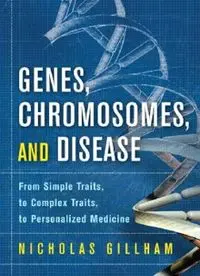
Genes, Chromosomes, and Disease: From Simple Traits, to Complex Traits, to Personalized Medicine PDF
Preview Genes, Chromosomes, and Disease: From Simple Traits, to Complex Traits, to Personalized Medicine
ptg Genes, Chromosomes, and Disease ptg This page intentionally left blank ptg Genes, Chromosomes, and Disease From Simple Traits, to Complex Traits, to Personalized Medicine Nicholas Wright Gillham ptg Vice President, Publisher: Tim Moore Associate Publisher and Director of Marketing: Amy Neidlinger Acquisitions Editor: Kirk Jensen Editorial Assistant: Pamela Boland Operations Manager: Gina Kanouse Senior Marketing Manager: Julie Phifer Publicity Manager: Laura Czaja Assistant Marketing Manager: Megan Colvin Cover Designer: Chuti Prasertsith Cover Illustration: Digital Art/Corbis Managing Editor: Kristy Hart Project Editor: Betsy Harris Copy Editor: Karen Annett Proofreader: Kathy Ruiz Indexer: Rebecca Salerno Senior Compositor: Gloria Schurick Manufacturing Buyer: Dan Uhrig © 2011 by Pearson Education, Inc. Publishing as FT Press Science Upper Saddle River, New Jersey 07458 FT Press offers excellent discounts on this book when ordered in quantity for bulk purchases or special sales. For more information, please contact U.S. Corporate and Government Sales, 1-800-382-3419, In memory of my brother Oliver ptg Wow! eBook <WoweBook.Com> This page intentionally left blank ptg Wow! eBook <WoweBook.Com> Contents Preface . . . . . . . . . . . . . . . . . . . . . . . . . . . . . ix Chapter 1 Hunting for disease genes . . . . . . . . . . . . . . . 1 Chapter 2 How genetic diseases arise . . . . . . . . . . . . . 25 Chapter 3 Ethnicity and genetic disease . . . . . . . . . . . . 55 Chapter 4 Susceptibility genes and risk factors . . . . . . . 81 Chapter 5 Genes and cancer . . . . . . . . . . . . . . . . . . . 103 Chapter 6 Genes and behavior . . . . . . . . . . . . . . . . . . 129 Chapter 7 Genes and IQ: an unfinished story . . . . . . . 151 Chapter 8 Preventing genetic disease . . . . . . . . . . . . . 175 Chapter 9 Treating genetic disease . . . . . . . . . . . . . . . 199 ptg Chapter 10 The dawn of personalized medicine . . . . . . . 235 Postscript: a cautionary note . . . . . . . . . . . 249 References and notes . . . . . . . . . . . . . . . . 253 Glossary . . . . . . . . . . . . . . . . . . . . . . . . . . 293 Some useful human genetics Web sites . . . 307 Acknowledgments . . . . . . . . . . . . . . . . . . . 309 About the author . . . . . . . . . . . . . . . . . . . . 311 Index . . . . . . . . . . . . . . . . . . . . . . . . . . . . . 313 This page intentionally left blank ptg Wow! eBook <WoweBook.Com> Preface The science of genetics began in 1900 with the independent rediscovery of Mendel’s 1866 paper by Carl Correns and Hugo de Vries. Until the middle of the nineteenth century, blending theories of inheritance pre- vailed, but it became clear to Charles Darwin and his cousin Francis Gal- ton that the hereditary elements must be particulate to provide the kind of variation upon which natural selection could work. Each of them pro- posed a particulate theory of inheritance, but the particles had to be hypothetical as the architecture of the cell and its different components were only beginning to reveal themselves to the curious eye. By 1900, a great deal was known about cell structure. In particular, chromosomes had been identified and Walther Flemming, a German scientist, had characterized their behavior in cell division (mitosis). Another German scientist, Theodor Boveri, provided evidence that chromosomes of the germ cell lineage provided continuity between generations. And in 1902, ptg an American graduate student, Walter Sutton, connected chromosomes with genes, in a classic paper. Thomas Hunt Morgan and his associates obtained experimental proof of the chromosome theory using the fruit fly Drosophila as a model. Working with Drosophila in his Fly Room at Columbia University, Morgan and his colleagues would elucidate many of the most important principles of Mendelian genetics. In England, William Bateson became Mendel’s great advocate. One would have thought such advocacy unnecessary except that, just about the time of Mendel’s rediscovery, Francis Galton had come up with a model of inheritance, which he called his Ancestral Theory. Particularly in Great Britain, there was much controversy in the first decade of the twentieth century between Galton’s supporters and Bateson. The Mendelians finally won out. In the course of these heated exchanges, Bateson became aware of the work of an English doctor, Archibald Gar- rod. Garrod was studying a disease called alkaptoneuria that caused the urine to blacken. His results suggested to Bateson that a recessive gene mutation might be involved. Bateson entered into a correspondence with Garrod, who in 1902 published a paper titled “The Incidence of Alkaptoneuria: A Study in Chemical Individuality.” And with that paper, Garrod made the first connection between a human disease and a gene.
